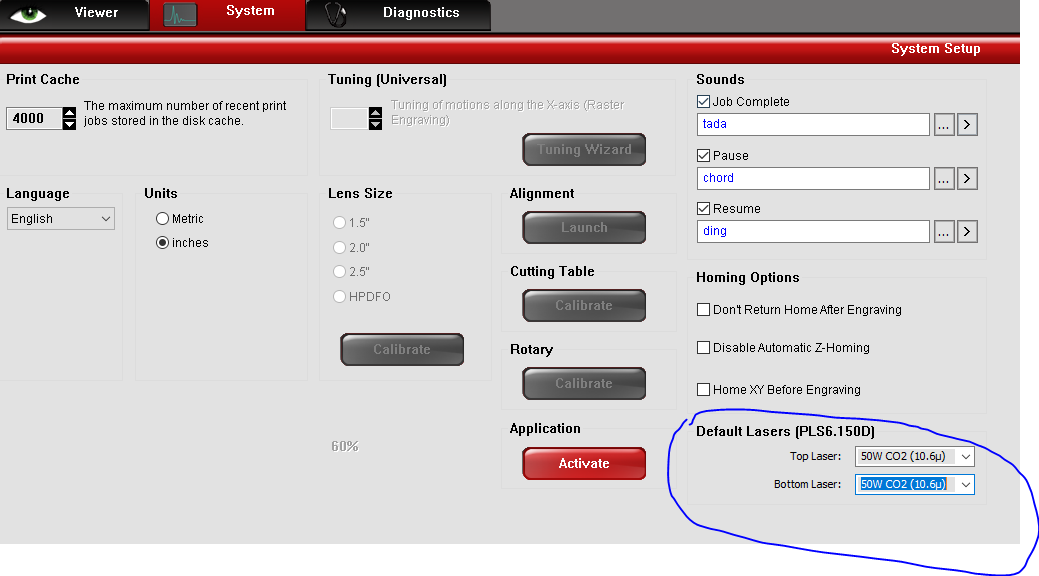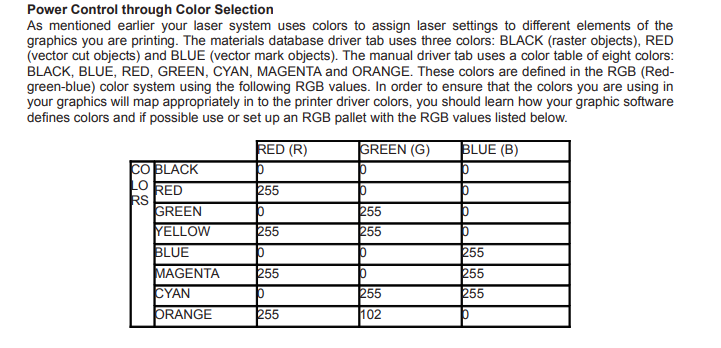Leesburg Lasercutter
The laser cutter we have is a ULS PLS6.150D laser. You can save some time and money by setting up your artwork on your home computer and uploading the resulting .emf file into the laser cutter's computer. You can do this by downloading and installing the laser print driver on your home computer. The drivers are available for download here http://www.ulsinc.com/support/software-downloads. Pick UCP Installer and follow the prompts for a PLS 6.150D. You should add the two 50W CO2 laser sources to get more accurate cut time estimates under the systems tab. Next, you will print your artwork to the PLS 6.150D from your art software. Check that both lasers are selected. You then will click on the file folder icon located at the top middle of the laser print driver screen. A dialog box should appear. Use the export to save your file to a thumb drive. When you get to the laser cutter computer open the laser print driver, click on the file folder icon and then import the .emf file. Click on the select button and you should be ready to run your file on the laser cutter.
The computer workstation in the 3-D printing room at Leesburg also has the laser print driver and CorelDRAW installed. You can follow the same process of printing to the print driver, saving the .emf file to a thumb drive and then importing the file onto the laser computer. There is no charge for using the 3-D printing room computer workstation.
The ULS website has a great materials list for what materials are good and not so good to laser here http://www.ulsinc.com/materials/
The below information was copied from http://atxhackerspace.org/wiki/Laser_Cutter_Materials and is also a good starting point on what materials can and cannot be cut.
Lasercutter Class Materials
Lasercutter Manual
Notes on Using Corel Draw
The version on the computers at the space is currently version 17 or X7
Best Places to Buy Acrylic:
https://www.inventables.com/categories/materials
Laser Calendar
Book by logging into Makersmith.org and selecting Members Only Content and then Laser Calendar Reservations. If you have any issue just email us at lasercutter@makersmiths.org
NEVER CUT THESE MATERIALS
WARNING: Because many plastics are dangerous to cut, it is important to know what kind you are planning to use. Make has a How-To for identifying unknown plastics with a simple process.
| Material | DANGER! | Cause/Consequence |
|---|---|---|
| PVC (Poly Vinyl Chloride)/vinyl/pleather/artificial leather | Emits pure chlorine gas when cut! | Don't ever cut this material as it will ruin the optics, cause the metal of the machine to corrode, and ruin the motion control system. |
| Thick ( >1mm ) Polycarbonate/Lexan | Cut very poorly, discolor, catch fire | Polycarbonate is often found as flat, sheet material. The window of the laser cutter is made of Polycarbonate because polycarbonate strongly absorbs infrared radiation! This is the frequency of light the laser cutter uses to cut materials, so it is very ineffective at cutting polycarbonate. Polycarbonate is a poor choice for laser cutting. |
| ABS | Emits cyanide gas and tends to melt | ABS does not cut well in a laser cutter. It tends to melt rather than vaporize and has a higher chance of catching on fire and leaving behind melted gooey deposits on the vector cutting grid. It also does not engrave well (again, tends to melt). |
| HDPE/milk bottle plastic | Catches fire and melts | It melts. It gets gooey. Don't use it. |
| PolyStyrene Foam | Catches fire | It catches fire, it melts, and only thin pieces cut. This is the #1 material that causes laser fires!!! |
| PolyPropylene Foam | Catches fire | Like PolyStyrene, it melts, catches fire, and the melted drops continue to burn and turn into rock-hard drips and pebbles. |
| Fiberglass | Emits fumes | It's a mix of two materials that cant' be cut. Glass (etch, no cut) and epoxy resin (fumes) |
| Coated Carbon Fiber | Emits noxious fumes | A mix of two materials. Thin carbon fiber mat can be cut, with some fraying - but not when coated. |
Safe Materials
The laser can cut or etch. The materials that the laser can cut materials like wood, paper, cork, and some kinds of plastics. Etching can be done on almost anything, wood, cardboard, aluminum, stainless steel, plastic, marble, stone, tile, and glass.
Cutting
| Material | Max thickness | Notes | WARNINGS! |
|---|---|---|---|
| Many woods | 1/4" | Avoid oily/resinous woods | Be very careful about cutting oily woods, or very resinous woods as they also may catch fire. |
| Plywood/Composite woods | 1/4" | These contain glue, and may not laser cut as well as solid wood. | |
| MDF/Engineered woods | 1/4" | These are okay to use but may experience a higher amount of charring when cut. | |
| Paper, card stock | thin | Cuts very well on the laser cutter, and also very quickly. | |
| Cardboard, carton | thicker | Cuts well but may catch fire. | Watch for fire. |
| Cork | 1/4" | Cuts nicely, but the quality of the cut depends on the thickness and quality of the cork. Engineered cork has a lot of glue in it, and may not cut as well. | Avoid thicker cork. |
| Acrylic/Lucite/Plexiglas/PMMA | 1/2" | Cuts extremely well leaving a beautifully polished edge. | |
| Thin Polycarbonate Sheeting (<1mm) | <1mm | Very thin polycarbonate can be cut but tends to discolor badly. Extremely thin sheets (0.5mm and less) may cut with yellowed/discolored edges. Polycarbonate absorbs IR strongly and is a poor material to use in the laser cutter. | Watch for smoking/burning |
| Delrin (POM) | thin | Delrin comes in a number of shore strengths (hardness) and the harder Delrin tends to work better. Great for gears! | |
| Kapton tape (Polyimide) | 1/16" | Works well, in thin sheets and strips like tape. | |
| Mylar | 1/16" | Works well if it's thin. Thick mylar has a tendency to warp, bubble, and curl | Gold-coated mylar will not work. |
| Solid Styrene | 1/16" | Smokes a lot when cut, but can be cut. | Keep it thin. |
| Depron foam | 1/4" | Used a lot for a hobby, RC aircraft, architectural models, and toys. 1/4" cuts nicely, with a smooth edge. | Must be constantly monitored. |
| Gator foam | Foam core gets burned and eaten away compared to the top and bottom hard paper shell. | Not a fantastic thing to cut, but it can be cut if watched. | |
| Cloth/felt/hemp/cotton | They all cut well. Our "advanced" laser training class teaches lace-making. | Not plastic coated or impregnated cloth! | |
| Leather/Suede | 1/8" | Leather is very hard to cut, but can be if it's thinner than a belt (call it 1/8"). Our "Advanced" laser training class covers this. | Real leather only!Not'pleather' or other imitations! |
| Magnetic Sheet | Cuts beautifully | ||
| NON-CHLORINE-containing rubber | Fine for cutting. | Beware chlorine-containing rubber! | |
| Teflon (PTFE) | thin | Cuts OK in thin sheets | |
| Carbon fiber mats/weave that has not had epoxy applied | Can be cut, very slowly. | You must not cut carbon fiber that has been coated!! | |
| Coroplast ('corrugated plastic') | 1/4" | Difficult because of the vertical strips. Three passes at 80% power, 7% speed, and it will be slightly connected still at the bottom from the vertical strips. |
Etching
All the above "cuttable" materials can be etched, in some cases very deeply.
In addition, you can etch:
| Material | Notes | WARNINGS! |
|---|---|---|
| Glass | Green seems to work best...looks sandblasted. | You can do flat glass on the etching table. Take the rotary advanced class for round objects like wine glasses. |
| Ceramic tile | ||
| Anodized aluminum | Vaporizes the anodization away. | |
| Painted/coated metals | Vaporizes the paint away. | |
| Stone, Marble, Granite, Soapstone, Onyx. | Gets a white "textured" look when etched. | 100% power, 50% speed or less works well for etching. |

